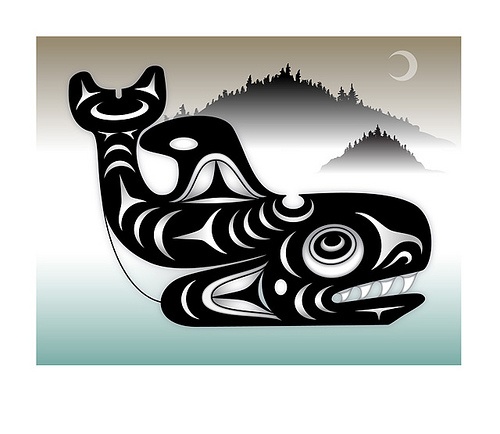
by Kevin McGrane
It is astounding to stand at the rail of a boat and suddenly have a humpback whale rise up from the water like a gopher rising out of his hole, barely arm’s length away. It silently elevates above the water’s surface, towering some 6 to 8 feet overhead – all gray, white and glistening – pauses for a fraction of a second at the top of its rise, then silently slides back down and disappears into the depths of the water.
Marine naturalists called this “spy hopping”, when a whale rises up to check out its surroundings. To C and me, we call it awe-inspiring.
We were on the Mega Nova, a 50-foot lobster boat that pulls double-duty as a tour and research vessel. Run by a marine research foundation, it helps pay for its research by educating the public with tours about ocean wildlife, particularly whales. The foundation operates out of Brier Island, a tiny spot of land only 12 square kilometers in size at the end of an archipelago that stretches into the Bay of Fundy from Nova Scotia.
It took us two solid days of travel by plane, car, and ferry just to get there. As we finally stood on the island’s bluff looking out to sea the afternoon we arrived, I felt like we were standing at the edge of the world. I said to C in my lame pirate’s voice, “Arr, beyond here there be monsters…”
She rubbed her hands together and beamed with excitement. “Ooo, I certainly hope so!” she said.
The next day we were on the Mega Nova with about 20 other people, motoring into the deep water of the bay. It was relatively calm and a bit foggy, but the fog was lifting with the rise of the sun. We saw nothing for the first 30 minutes but flotillas of sea birds riding the waves.
I was surprised by the amount and variety of bird life living on the ocean. The tour naturalist described how most of the species we saw only live on the shore to nest, lay eggs, and hatch their young – the rest of their entire lives are spent at sea.
With no whales sighted, the guide decided to stop the boat and asked everyone to be silent, as we might hear a whale before we see one – sound can travel for a mile over calm water. Sitting in the boat with the engine cut off, the bay was preternaturally quiet. The entire ocean was soundless.
Suddenly, we heard a distant “whock!”, and both the pilot and guide leaped to their feet with a “Whoa!” pointing to starboard. The engine coughed to life and we were off, following the sound – the guide said it was the sound of a whale tail slapping the surface of the water.
In a minute we spotted two whales in the distance, rolling up and down in the water side by side, blowing plumes of water from their blow holes. They seemed to be in no particular hurry and the boat pulled parallel with them some 200 meters’ distance. The guide explained that there is a protocol regarding boats encountering whales, and the tour boat followed the protocols to the letter: never crowd a whale.
C and I agreed later on that if this was the closest we would get to a whale in the wild, then the entire trip was a success. They rolled in unison alongside the boat, keeping pace and blowing plumes. You cannot imagine our surprise when the whales slowed down, turned to their left, and approached the boat to investigate.
They came up alongside as if to visit, and the captain cut the engines. The massive, 50-foot long humpbacks swam around us, under us, floated alongside the hull and blew a couple of plumes (surprise! plumes stink!). The whales hung with us for a good ten minutes then calmly went on their way. We were slack-jawed. Never in our wildest expectations did we expect to see whales this close up in their environment.
Yet, we had encounters like this for the next three hours.
Pods of whales approached the boat to investigate. Others swam alongside but were in a hurry to get wherever they were going and swam on. Even a mother and child stopped by to check us out. The mother floated some 20 meters off port as her baby – an infant some 20-feet long – played a game of swimming under the boat and popping up to the surface, then diving back down and popping up on the other side, back and forth for several turns. It reminded me of a puppy running back and forth in the yard. Then I remembered that we were watching mammals, not fish. Why would it be so surprising to see a mammal act like a mammal?
We finally got back to shore, and as we took the ferry back to the archipelago, I remembered the psalmist who sang about the Leviathan.
Yonder is the sea, great and wide,
Creeping things innumerable are there,
Living things both small and great.
There go the ships,
And Leviathan that you formed to sport in it.
–Psalm 104:24-26 NRSV
I now have a deeper insight into the phrase “And Leviathan that you formed to sport in it”. God created the whale not for our consumption or entertainment; our existence has nothing to do with the creation of the whale. God created the whale for its own sake; for God to enjoy the whale and for the whale’s joy of its own sport. The whale has its own sacredness.
According to the psalmist, God takes pleasure in the joy of creation – creation needs no other reason for being than that. Creation’s worth, including our worth, resides in God’s joy about creation’s very existence. It strikes me as nothing less than pure love, pure sacredness.
As I stood on the rocking deck of the Mega Nova, watching the whales sport in the vast bay, I felt the thrill of pure joy in God’s creation, and felt God’s Own Self within me. I appreciated like never before God’s love for all of us – whales, birds, people, all creation.
A very sacred moment, that.
Deacon Kevin J. McGrane serves in the Diocese of Missouri at St. John’s – Tower Grove parish. He and his wife “C” live on ten acres in the Ozarks along with Daisy the Wonder Dog. They have 3 children, 9 grandchildren, and goats will joining them this summer.

